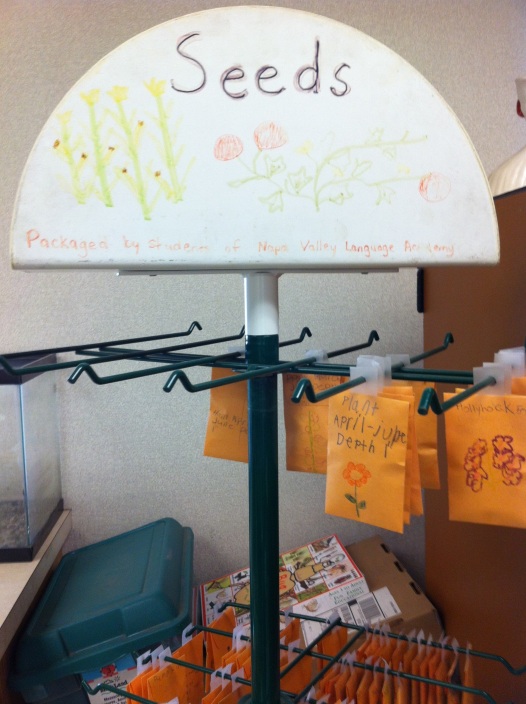Recently, a group of Napa educators gathered to explore the benefits of seed saving at their monthly “Learning Hour.” Drawing on a number of resources and experiences, we shared the benefits and techniques for successful seed saving. Here are six reasons why saving your own seed is useful for school gardens.
- Connect to history. Seed saving is 10,000 years old–as old as human civilization. In fact, seed saving is one of the earliest practices of agriculture. Selecting plants to grow in a single location enabled groups to settle rather than to range open land in search of resources such as “the five Fs” of agriculture (food, fuel, forest, fiber, and flowers).
- Preserve cultural heritage. Seed saving preserves varieties favored by different cultures throughout time. Heirlooms, specifically, have been selected and passed down for many generations, often savored for their flavor rather than yield (as many commercially cultivated varieties today).
- Promote biodiversity and local adaptation. A typical nursery might carry several varieties of tomatoes or corn, but seed catalogs carry dozens. Each company specializes in its own cultivars. Invest in a kind you love and you can develop a crop that thrives in your school garden microclimate.
- Save money. Seed saving is practical and economical. A seed packet ranges from $1 per pack (of 20-100 seeds), whereas seedlings or starts cost about $3-$6 for a six pack. Even specialty brands that might be closer to $4 each (e.g. Hudson Valley Art Packs) are a bargain.
- Engage students in science. Once you find several varieties of vegetables you love, you can save one plant or bed worth of seed for the following season and collect stats from year to year. Tracking characteristics such as germination rates, days to harvest, and yield introduces students to data collection and analysis.
- Teach important lessons. Not only does seed saving illustrate life cycles and seasonality, it also teaches about abundance, stewardship, and a sense of place (Occidental Arts & Ecology Center, A Handful of Seeds).
Simple Seed Saving Activities:
- Empty all your expired seeds into a bowl and have kids sort them by shape, size, color, etc. An egg carton works especially well for this. Expired seeds also make good bird feeder material.
- Use different tools to extract seeds from a sunflower head (e.g., tweezers, popsicle sticks, spoons). Have students compare this simulation to different bird beaks.
- Write procedures for how to start seeds. Use seeds that germinate quickly, such as beans. Ask younger students to follow the directions.
- Measure bean seed pods or count bean seeds as they shuck them from their pods. Have them track the data and average the total.
- Obtain a pack of seeds that is 1-2 years old and conduct an investigation into germination rates of different crops.
- Conduct a seed snack taste test. Sunflower seeds, pumpkin seeds, pomegranate seeds, or fresh fava beans make good choices (beware, some students are allergic).
- Practice reading seed packets. Design unique seed packets and sell them.
Seed Saving Resources:
UC Master Gardeners of Napa County Healthy Garden Tips offer easy-to-digest information sheets on a variety of topics.
Demeter Seed Project: The Demeter Seed Project of UC Santa Cruz is a student-run, non-profit organization of local farmers and gardeners who believe in the importance of preserving the genetic heritage of our food.
Seed Matters: An initiative of the Clif Bar Family Foundation, Seed Matters aims to conserve crop diversity, uphold farmers’ stewardship, and support public research and education.
Seed Savers Exchange: As a nonprofit, Seed Savers Exchange aims to conserve and promote America’s culturally diverse but endangered garden and food crop heritage for future generations by collecting, growing, and sharing heirloom seeds and plants.
Learning Hour is a free monthly offering for sharing tips and strategies for successful school gardens. For upcoming Learning Hour topics, visit the Napa Valley School Garden Network.




